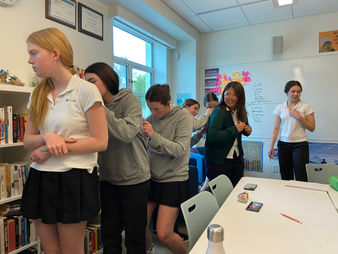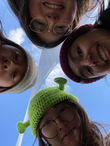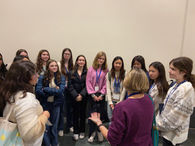Our Editing Process
On The Oracle, we use multiple programs to track story progress, published stories, source tracking in Google Sheets and Trello to keep track of our progress.


1
3
2
4
5
6
Articles have a six-part life cycle on The Oracle, all organized on Trello:
1
Story Pitch: If a staff reporter, senior reporter or editor has an idea for a piece, they can create a Trello Card. Inside the card, students will declare the section they are writing for and state the story's angle, potential sources/research and photo/multimedia/sidebar ideas in the card description before starting. These Trello Cards are story ideas that anyone can decide to work on, but no reporter is working on yet.
Reporting/Drafting: When a story has been approved by a section editor to be worked on, students move or create cards to this section to begin the writing/multimedia process. On top on creating the description, students will now add a checklist appropriate for the story. Students will now research, collect interviews, take photos and draft their stories before tagging the respective section editor that the story is ready for edits.
2
3
Section Editor ↔ Editing/Fact-Checking: The article will now go through multiple rounds of edits between the section editor and reporter, moving between the two columns until the section editor deems the story is ready for the Editor-in-Chief's edits.
Editor-in-Chief ↔ Editing/Fact-Checking ↔ Adviser Edits: Similar to the section editor's edits, multiple rounds of edits will happen between the EIC and reporter, thus moving the card between the EIC and Editing/Fact-Checking column. Once ready, the EIC will tag our journalism adviser Ms.Taylor to give her edits. Ms.Taylor leaves final feedback on the Trello card for the reporter and editor to consider, but the students will always have final say about the edits ma does not edit directly on the articles, but instead will leave a list of edits as a comment on the card. When these edits are completed, the reporter will send the article back to the EIC.
4
5
Published: When the EIC deems the story has no more edits, she will publish the story on our news site The Oracle. Each section editor is responsible for sponsoring stories in their section on our social media platforms.
Sent in Newsletter: After a story has been published, it is added to the collection of stories published within the week to display in the weekly newsletter.
6




From work-in-progress and multicolored to published and green!
Color Key —
White: Drafting
Yellow:Section Editor
Blue: EIC
Purple: Ms.Taylor/Adviser
Green: Published
Red: Missing/late

Last year, I realized certain students were continuously used as sources, but couldn't seek out new sources because the article's deadline had already passed. To track who we are covering, what grades need more coverage and what sources have been overcovered, we created a source tracking Google Sheet document for both articles and social media posts/reels to ensure we feature as many students and faculty as possible.

When a source has been used in three articles, it will be highlighted yellow. When a source has been in four or more articles, it will be highlighed red. Students check this sheet before deciding sources.

Multimedia Editing
As the Multimedia editor during the 2022-2023 school year, I was able to answer any and all Multimedia questions to my fellow staff members. For the most part, I edit the podcasts coming to me from the multimedia class as well as any broadcasts students created.
Each month, they send me their audio file for an episode and I leave edits as bullet points in Trello and tag the individual. This will continue until I deem the podcast ready to be sent to the Editor-In-Chief. This is the same editing process that takes place for broadcast videos.

As we create podcasts in Adobe Audition, I help reporters edit directly in Audition to help familiarize them to the audio program and common mistakes in audio.
Typically though, I will download the podcast or broadcast onto my computer and leave notes as a comment on the Trello card. Notes will include time stamps to adjust volume, re-recording, music and cutting audio. Additional notes for broadcasts including more or less A or B-roll.


Feature Editing
Now, as the Features editor this school year (2023-2024), I focus on less on multimedia and more on written edits. Below is a short snippet of me helping a staff reporter edit:
Leadership
In my opinion, my form of leadership is the closest to servant leadership, which prioritizes the growth and well-being of the reporters around me. No matter if I have an article to work on that day, I will always carve time during the day or night to assist the other reporters with whatever task they need help with. Editing, photography, podcasting, editing audio and video, graphic illustration and the list keep going. Because of my helpful nature, I believe I am highly approachable, and I constantly work on build healthy relationships with the other staffers my saying hi to them in the hallways or starting up a conversation during a passing period. My empathetic nature takes focus most often than not, but I believe the hyperawareness I have of others is what gives me the most strength to help as a leader and an editor.
Because there are two sections or periods of the journalism program, the staff is divided and works separately most of the time. Thus, we used one of the FLX blocks each rotation to either plan as a editorial board or meet as a full staff.
Our full staff meetings typically include two parts: time for connection and time for learning or planning. For connection, we might do a short game or journalism group warm-up or something that takes more time like a round of Kahoot! Afterwards, we'll either brainstorm for the month or review key journalism topics such as interview or editing tips.

From planning in Google Docs to connecting in person!

In our Editorial Board meetings, we spent parts of the meeting planning for all staff meetings where we would review common editing mistakes and strive to build connection. In the future after returning from my journalism summer programs, I want to help Ms.Taylor and Audrey plan the beginning lessons at the start of class to continue our learning, even after being an intro student.
Team Building
Because my experience on The Oracle kickstarted as soon as we were back in person, fostering the staff's dynamic was vital to me. The Oracle welcomed me with open arms, and I grew more and more attached to the program. There was the joy of ringing the bell, of speed dating from FLX block and a big celebration at the end for the seniors and rising staff that you never forget.
The influx of new reporters on the staff during my second year caused the publication to change from one period to two. This led to a small divide in the publication, which made me more adamant about bringing us all together. By connecting with the new students between passing periods, the journalism convention trip and during our shared FLX block meetings, where FLX is one of the periods we have in an eight-day rotation. I hope to continue fostering team dynamic in the future.







